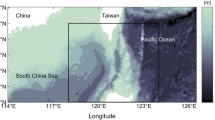Summary
Simple analytical solutions to the momentum and continuity equations have been used to obtain phase relationships between the M4 and M2 tides for both frictionless solutions, and when there is an assumed local balance between production and dissipation of the M4 tide. These solutions allow the observed phase relationships for the tidal elevations to be used to indicate the probable phase relationship between the M4 and M2 tidal flows and hence the direction of maximum tidal flow.
Application to the Bristol Channel indicates that in the upper reaches the peak flood flow would be expected to exceed the peak ebb flow whereas in the lower reaches the converse applies; this agrees with the observed parting in the direction of bedload transport near the middle of the Bristol Channel.
Zusammenfassung
Es werden einfache analytische Lösungen der Bewegungs- und Kontinuitätsgleichungen verwendet, um Phasenbeziehungen zwischen den M4- und M2-Teiltiden zu erzielen, und zwar sowohl für Lösungen ohne Reibungsverluste als auch unter der Annahme eines örtlichen Gleichgewichts zwischen Erzeugung und Vernichtung der M4-Teiltide. Mit diesen Lösungen können die beobachteten Phasenbeziehungen für die gezeitenbedingten Wasserstände verwendet werden, um auf die wahrscheinliche Phasenbeziehung zwischen den M4- und M2-Tidenströmen und daher auf die Richtung des maximalen Tidenstroms hinzuweisen.
Die Anwendung auf den Bristol-Kanal deutet darauf hin, daß in den oberen Bereichen des Kanals damit gerechnet werden kann, daß der maximale Flutstrom den maximalen Ebbstrom übersteigt, während in den unteren Bereichen das Gegenteil gilt. Dies stimmt mit der beobachteten Richtung des Sedimenttransports in der Nähe der Mitte des Bristol-Kanals überein.
Résumé
On a utilisé une résolution analytique simple des équations d'impulsion et de continuité pour obtenir des relations de phase entre les ondes de marées M4 et M2, soit dans un modèle sans frottement, soit lorsque la formation et la dissipation de l'onde M4 sont supposées localement équilibrées. Ces solutions permettent d'utiliser les relations de phase observées dans les hauteurs de marée pour indiquer la relation de phase probable entre les courants de marée M2 et M4 et par suite la direction du courant maximal.
L'application au Canal de Bristol montre qu'il faut s'attendre que dans les biefs supérieurs, le courant de flot maximal dépasse celui du jusant, tandis que c'est l'inverse dans les biefs inférieurs; ceci est en accord avec la direction observée du transport des sédiments près du milieu du Canal de Bristol.
Similar content being viewed by others
Abbreviations
- ω:
-
Angular frequency of the M2 tide
- k :
-
The M2 tide wavenumber
- x :
-
The coordinate aligned parallel to the coast
- t :
-
Denotes the time
- t 1 :
-
t−kx/ω
- h :
-
The undisturbed water depth
- ζ:
-
The elevation of the sea surface
- g :
-
The acceleration of the earth's gravity
- ρ:
-
The density of seawater
- A 1 :
-
The amplitude of the M2 tidal elevation
- B 1 :
-
The amplitude of the M2 tidal flow
- u 1 :
-
The water speed associated with the M2 tide, positive in the positivex direction
- u 2 :
-
The water speed associated with the M4 tide, positive in the positivex direction
- u 0 :
-
The time-averaged mean water speed positive in the positivex direction
- τx :
-
The bottom stress
- r :
-
The quadratic frictional coefficient
- B 2 :
-
The amplitude of the M4 tidal flow
- Φ :
-
The phase of the M4 tidal flow
- Φ 1 :
-
Tidal flow phase M4−2M2
- f, Φ:
-
Amplitudes of the M4 tidal flow
- ψ, γ:
-
Amplitudes of the M4 tidal elevations
- Ψ :
-
Phase of the M4 tidal elevation
- Ψ 1 :
-
Tidal elevation phase M4−2M2
- a, b :
-
Fourier coefficients of the series expansion of the bottom stress
- c :
-
The amplitude of the tidal elevation at the entrance to a bay of lengthL
- β:
-
Spatial decay parameter
References
Doodson, A. T. and H. D. Warburg, 1941: Admiralty manual of tides. London: Hydrographic Department, Admiralty. 270 pp.
Heath, R. A., 1974: Physical oceanographic observations in the Marlborough Sounds. N. Z. J. Mar. Freshw. Res.8, 691–708.
Ippen, A. T. (ed.), 1966: Estuary and coastline hydrodynamics. New York [usw.]: McGraw Hill. XVII, 744 pp. (Engineering Societies Monographs.)
Jeffreys, H., 1970: The earth — its origin, history and physical constitution. Cambridge: University Press. 420 pp.
Lamb, H., 1932: Hydrodynamics. Cambridge: University Press. 738 pp.
Pingree, R. D. and I. R. Griffiths, 1979: Sand transport paths around the British Isles resulting from M2 and M4 tidal interaction. J. mar. biol. Assoc. U.K.59, 497–513.
Proctor, R., 1979: Residual circulation studies in the Irish Sea. Ph.D. thesis lodged in the University of Liverpool Library.
Proudman, J., 1953. Dynamical oceanography. London: Methuen. 409 pp.
Stride, A. H., 1973: Sediment transport by the North Sea. In: North Sea Science. Ed.: E. A. Goldberg. Cambridge, Mass.: MIT Press, Pp. 101–130.
Author information
Authors and Affiliations
Rights and permissions
About this article
Cite this article
Heath, R.A. Phase relations between the over- and fundamental-tides. Deutsche Hydrographische Zeitschrift 33, 177–191 (1980). https://doi.org/10.1007/BF02226319
Received:
Published:
Issue Date:
DOI: https://doi.org/10.1007/BF02226319




